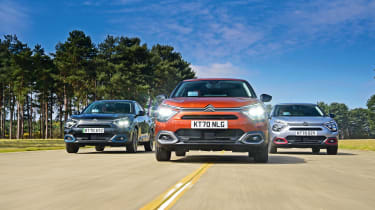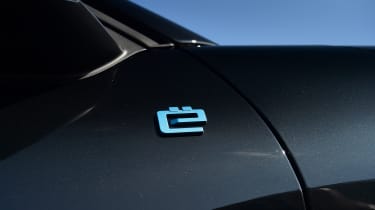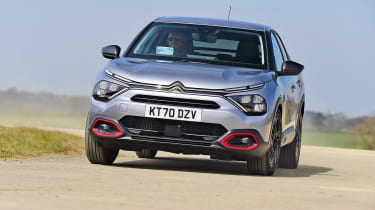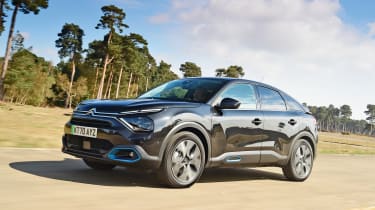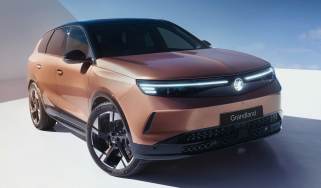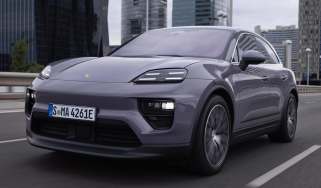What is the best fuel for your next car?
Three Citroen C4s, three different fuel options but which is best?
The switch to electric drive is gathering pace, with more manufacturers than ever now offering electric cars alongside their combustion-engined counterparts.
While the development of EVs has accelerated in recent years, it’s still difficult for some buyers to make the sums add up. One obstacle to this is that comparing EVs and combustion-engined cars on a like-for-like basis isn’t as clear-cut as it could be, especially in terms of costs. But fear not, because Auto Express is here with a trio of cars that will help you to determine the best power source for you.
At the moment, the Stellantis Group is one of the few car makers that sells models with the choice of petrol, diesel or electric drive. It’s offered in a variety of Citroen, Peugeot and Vauxhall models, but here we’ve lined up three Citroen C4 hatchbacks to analyse the differences. We’re focusing on the driving experience, everyday practicality and those all-important running costs to see which delivers the best balance of talents.
Design & engineering
Whether you choose petrol, diesel or electric power, the Citroen C4 uses Stellantis’s Common Modular Platform (CMP) that features under a wide variety of models, from the Peugeot 208 to the Vauxhall Mokka. The C4 is one of the larger cars to use CMP, and it’s an interesting-looking crossover. Our three C4s are in Shine Plus trim, and they’re largely identical, except that the e-C4 has a unique wheel design and metallic-blue trim pieces inside and out.
All three are front-‘engined’ and front-wheel drive, and the only other visual clue to the e-C4’s alternative set-up is in the boot. To make space for the battery under the passenger compartment, the spare-wheel well is half the size of that found in the petrol and diesel models. This means you can’t add a spare wheel to the e-C4, but then, it’s not an option on the combustion-engined cars, either.
The biggest difference between them is something you can’t see: weight. The e-C4 is considerably heavier than the other two. It tips the scales at 1,541kg, which is 263kg more than the petrol C4, or the equivalent of driving around with three large adult passengers on board at all times. Weight is an issue to bear in mind when creating an EV, and at the moment Stellantis has gone with a 50kWh battery for the best compromise between mass and range.
Diesel engines are often heavier than petrol units, and the BlueHDi car here is 46kg more than the C4 PureTech. While not as great as the e-C4’s, this difference still has an impact.
Driving
While all three cars use the CMP platform, their powertrains mean they’re all different to drive. Go for a petrol C4, and you get a 1.2 PureTech turbocharged three-cylinder engine, here making 129bhp. Diesel models use a four-cylinder 1.5 BlueHDi motor that matches the PureTech’s power output, but with 300Nm, there’s more torque and it’s made from 3,750rpm; the PureTech’s makes 230Nm at 5,500rpm.
The e-C4 has a 134bhp electric motor with 300Nm of torque available virtually the instant you touch the throttle. Our two combustion-engined cars also came with Citroen’s EAT8 automatic gearbox, so they’re just as easy to drive as the single-speed e-C4. The petrol C4’s lighter kerbweight means its 0-62mph time of 9.4 seconds is 0.1 seconds faster than the diesel’s. In comparison, the e-C4’s instant response means it sprints off the line, but then its weight comes into play, so 0-62mph takes 9.7 seconds. The e-C4 sprints away with minimal fuss and noise, though – just the faint whine of the electric motor as the car gathers speed. By contrast, the C4 diesel is rather rattly, but it’s only overly harsh when starting from cold, while the C4 petrol has a sporty three-cylinder thrum.
One downside of the combustion-engined cars is Citroen’s EAT8 automatic gearbox. It’s not a great auto, because it’s slow to react and delivers hesitant shifts, so it’s harder to make smooth progress than in the e-C4. Shine Plus models are auto only, but there’s a manual gearbox on offer in lower-spec C4s. However, Citroen’s six-speed transmission isn’t the smoothest to use, either.
The weight differential between these three cars has a profound effect on the way they handle. The PureTech-powered C4 feels the liveliest and turns in eagerly, while the BlueHDi tends to understeer more readily, thanks to the extra weight in its nose. The e-C4 doesn’t suffer in the same way because all of its extra weight is located low down and between the axles. It doesn’t feel as sprightly as the petrol C4, but the extra weight gives it better stability, so it’s not as badly affected by mid-corner bumps. This stability can also be felt when cruising, because the e-C4 is far more comfortable than its stablemates at all speeds, and manages to iron out most bumps with ease.
With Citroen’s focus on comfort, the e-C4 makes a strong case for itself when compared with the combustion-engined cars; it’s more comfortable, easier to drive and quieter, too.
Practicality & running costs
In terms of everyday usability, there are few compromises with the e-C4. Apart from the smaller wheel well beneath the split-level boot floor, space on board is identical to that in the other C4s. All three come with a 380-litre boot that expands to 1,250 litres with the back seats folded, while rear-seat space is identical, too. Up front, the auto-equipped C4s use the same style of drive selector toggle that’s found in the e-C4, but the latter does without paddleshifters behind the steering wheel for its single-speed transmission.
The practicalities of using electricity instead of fossil fuel do have an impact on how far you can go on a fill. While the e-C4’s battery takes up more space than the tanks found in the C4s, the lithium-ion cells aren’t as energy-dense as petrol or diesel. Citroen quotes a WLTP-tested maximum range of 217 miles, but if you can match the petrol’s WLTP fuel economy of 48.7mpg, then you’ll have a range of 536 miles. Go for the C4 diesel, and averaging 64.5mpg WLTP nets you a healthy 709 miles from the 50-litre tank. For some buyers, the lack of stops needed by the diesel will still be attractive.
It comes at a cost, though. Based on an electricity price of 26 pence per kWh, you’ll spend around £576 to travel 12,000 miles in the e-C4 at an energy-consumption rate of 5.4 miles per kWh. To cover the same distance in the petrol C4 (at an average UK fuel price of £1.63 per litre), you’ll need to fork out £1,826, while the diesel (at a UK average of £1.50 per litre) costs £1,497. Of course, there are many variables when it comes to electric-car charging, with some slower public chargepoints offering free energy, while rapid chargers are usually more expensive than a household supply. Then there’s the impact of cold weather on range, which can be reduced dramatically in some instances.
There’s no escaping that EVs are more expensive to buy than their combustion counterparts, but the gap is narrowing and the lower everyday running costs are where the savings are made. A list price of £34,995 for the e-C4 is reduced to £32,495 when you add the Government’s Plug-in Car Grant (PiCG), but it’s still £5,635 more than the petrol C4. If you haven’t got a home charging wallbox, then you’ll need to factor that in, too; budget at least £400, maybe more if you need to upgrade your home electricity supply.
Using the PiCG price and based solely on the cost to fill up (3p per mile for the e-C4, 14ppm for the petrol car), you’ll need to cover around 50,000 miles to recoup the difference in list price between the e-C4 and the petrol C4.
There are further savings elsewhere with the e-C4, though. Free road tax (compared with £155 a year for the combustion cars), exemption from congestion charges and cheaper servicing costs will appeal to private buyers, while business users see their Benefit-in-Kind rates slashed. The 2021-22 tax year sees a one per cent BiK rate, rising to two per cent for 2022-23, but that’s still a fraction of the cost for the diesel, which itself offers a modest saving over the petrol C4.
Buy any of these cars direct from Citroen’s online store and there are additional savings. The e-C4 has £4,000 off its list price, and on a three-year PCP deal with a £5,000 deposit and 10,000-mile annual limit, monthly repayments are £355. The petrol C4 is £40 a month less than the e-C4 at £315, but the diesel C4 is relatively uncompetitive, costing £365 a month, £10 more than the electric model.
Of course the other draw of the e-C4 will be the environmental impact of its zero-emissions running, which some people will be happy to pay for, for a clear conscience.
Verdict
Comparing three models where the only difference between them is their power source sheds light on the development of electric drive. In the instance of the Citroen C4, the electric version delivers a better driving experience than the combustion-engined cars, with excellent refinement, and its extra weight improves the car’s ride.
The only reason we’d choose diesel is to cover lots of miles without the inconvenience of having to stop as frequently as in an EV. For a fun driving experience, petrol still leads the way, and here it delivers the running costs and range that make it a tempting alternative to diesel.
Buy on finance, and the main obstacle to electric ownership – a high purchase price – is largely eliminated. Add in everyday running costs that are just a fraction of those for petrol power, and the e-C4 makes a strong case for itself. Even if you buy outright, those savings will go a long way to justifying the car’s higher initial cost, while the company car rates are simply too good to ignore.
Read Andy Palmer's take on electric car charging infrastructure and why it needs to improve...
